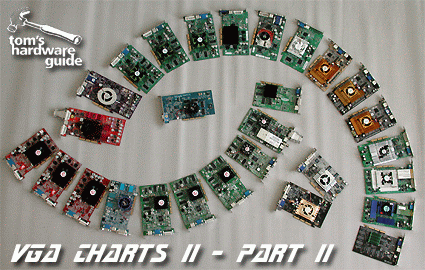VGA Charts II: Mainstream Systems
VGA Charts II - Part II

While the first part of the Tom's Hardware Guide VGA Charts focused on high-end system, this time we're interested in how 31 video cards fare when coupled with a slow machine. For this purpose, we'll compare our existing results achieved with the Athlon XP 2700+ system from the first round to those of an Athlon 1000 system based on a VIA KT 133A chipset with 256 MB CL2 RAM.
To round off our survey, we'll also check out the performance of 13 current cards with 8x anisotropic filtering, 4x full scene anti-aliasing and a combination of both, as a test of the highest quality setting that is still playable. These tests are also run in 1024x768-32, which makes them virtuall unplayable on older-generation cards.
A new addition to the low-end (if that's what you want to call this system) tests is the 64 MB version of the Kyro II, which we couldn't test on the newer motherboards due to its 3.3V AGP 2X interface. The Kyro II SE, which already uses the more modern 1.5V AGP 4X interface was unfortunately not available to us for testing. The Matrox Parhelia, meanwhile, proved to be incompatible with our KT 133A motherboard (ABIT KT7A). Although the system would start up, the screen remained blank. Therefore we were unable to record any results for this card on the Athlon 1000 system.
For the sake of consistency, all Ati cards were tested using version 2.5 of the Catalyst driver. Besides, the newer Catalyst 3.0 was not available at the time the tests were conducted. Also, DirectX 9 would have affected our results.
Stay on the Cutting Edge
Join the experts who read Tom's Hardware for the inside track on enthusiast PC tech news — and have for over 25 years. We'll send breaking news and in-depth reviews of CPUs, GPUs, AI, maker hardware and more straight to your inbox.
Most Popular

